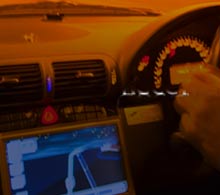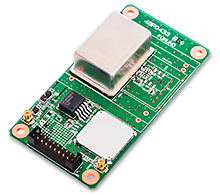Articles for ITS market
"Moving toward zero traffic fatalities for four-wheeled and two-wheeled vehicles globally in 2050"
~Experience on Honda's latest safety technologies~
 Keiji Otsu, president of Honda R&D, gives a presentation to the press. Photographed by the author.
Keiji Otsu, president of Honda R&D, gives a presentation to the press. Photographed by the author.
 At Honda's Sakura Test Course (Sakura City, Tochigi Prefecture). Photographed by the author.
At Honda's Sakura Test Course (Sakura City, Tochigi Prefecture). Photographed by the author.
Honda's philosophy of safety
At the end of November 2021, the author participated in “Honda Safety Vision and Technology Report Conference” held by Honda at Sakura Test Course (Sakura City, Tochigi Prefecture).
While there participants were able to experience the various safety technologies that have been introduced to the market in recent years and those currently under research and development.
Honda's safety philosophy is "Safety for Everyone".
Keiji Otsu, president of Honda R&D, reiterated Honda's founder Soichiro Honda's desire to "respect life" and "proactive safety." "We want to create a society where everyone on the road can be safe and not be involved in accidents.”
“Proactive safety” is a concept that aims to create a safe traffic society in which traffic participants do not take a passive stance toward safety, but still enjoy free movement.
This is Honda's corporate principal. "Let your curiosity lead you outward and enjoy the real world with all your senses and sensibilities" (President Otsu).
Now, looking at the social reality, the number of deaths worldwide due to traffic accidents is about 1.35 million per year (WHO, 2018). 392,000, or about 30% of the total death, are related to four-wheeled vehicles, and 378,000, slightly less than four-wheeled vehicles, are related to motorcycles. This is followed by pedestrians at 310,000 and bicycles at 41,000, with the remaining 229,000 classified as other accidents.
By country and region, India has the largest number at 300,000, which is addressed by a high proportion related to motorcycles, at around 40%.
The second highest country was China of 256,000, with pedestrians accounting for up to 30% of the total deaths.
It is clear that the large population of India and China, both in excess of one billion has contributed to the high number of traffic fatalities, but at the same time it is assumed that these are consequences related to the inadequate development of transport infrastructure and responsible safe driving.
Excluding India and China, the rest of Asian regions accounted for 155,000, with a high proportion of traffic fatalities among both motorcyclists and pedestrians.
In developed countries, 85,000 people in Europe and 42,000 people in North America were killed in four-wheeled traffic accidents, accounting for more than 60% of the total number of fatalities in these countries.
On the other hand, the number of Japan is 0.5 million (2,839 in 2020), which is relatively small.
In 1970, the number of traffic accident fatalities in Japan reached a record high of 16,765, due to the spread of private cars as a result of the country's rapid economic growth after WWII. The number showed a rapid downward trend in the 1970s as the Japanese government began to reinforce its traffic policies. Although the number of traffic fatalities continued to increase again in the 1980s, but from the 1990s, the number decreased thanks to the development of collision safety technology and the evolution of preventive safety technology since the 2010s.
Different approaches to reducing traffic fatalities in developed and emerging countries
In the midst of these social changes, Honda has declared that its future goal is "to achieve zero traffic fatalities involving Honda motorcycles and automobiles worldwide by 2050.
This is an extremely high target that covers not only new car sales, but also all of Honda's vehicles in the global market, with an intermediate target of halving the number of traffic fatalities in the global market by 2030.
In order to achieve this goal, it is suggested that three areas of mobility performance, transport ecosystem and human capabilities should complement each other and also create synergies.
In addition, since there are significant differences in the traffic environments of countries and regions, safety promotions need to be customized locally.
Particularly in developed countries, 62% of the fatal accident scenes in 2020 will be covered by the technological evolution and increased integration of Honda Sensing, an advanced driving support system. The remaining 38% will be covered by enhanced collision protection function for pedestrians and advanced automatic notification system for accidents.
Meanwhile, in emerging countries, Honda Sensing and the evolution of motorcycle safety technology will contribute 50%, and the remaining 50% will be covered by safety education activities and safety promotion by government agencies.
Beyond Technology: Predicting Human and Bicycle Behavior
At Sakura test course, we test drove a prototype equipped with Honda Sensing 360, an upgraded version of Honda Sensing that is already in mass production.
The detection capability of each sensor has been improved, especially the use of millimeter wave radar for medium range in the forward diagonal direction.
In recent years, other automakers have introduced advanced safety technologies that use millimeter wave radar mounted on both sides of the front bumper to help prevent collisions at intersections with poor visibility. In most cases, millimeter wave radar uses 24GHz frequency band, and the detectable distance is about 20 to 30 meters. It is installed at both ends of the rear bumper to detect vehicles approaching from diagonally behind lane and to detect the movement of surrounding vehicles when reversing.
Alternately, Honda Sensing 360 seems to use the “70GHz band millimeter wave radar", but the technical details were not disclosed.
In addition, what caught the author's attention was the use of AI (artificial intelligence) to predict the behavior of people and bicycles etc.
The image recognition camera detects the movement of human's major joints and the direction of their faces and predicts the direction they will move. Currently it is difficult for image recognition camera technology for automobiles to detect small/short animals, but in future the developing technology can be improved to predict the movements of small animals.
The research on human behavior using brain science findings was also very interesting.
The V2X World: Connecting Cars to Society
By 2030, the company aims to halve the number of traffic fatalities from the 2020 level Beyond that from 2030 to 2050, it aims to create a V2X world in which cars and society as a whole are connected through communications.
For example, in V2P (Vehicle-to-Pedestrian) communication, an in-vehicle image recognition camera detects human movement. Using edge computing technology at a 5G base station, it sends an alert to a pedestrian's smartphone to warn them of an approaching vehicle. This technology is being tested jointly with SoftBank and is expected to be put to practical use in conjunction with the social implementation of 5G.
Honda's role is to provide appropriate information according to each traffic participant's condition and traffic scene.
However, as for the method of providing the information, "standardization through public-private cooperation is necessary.”
In this context, Prime Minister Fumio Kishida held the first Temporary Digital Administrative Investigation Committee on November 16, 2021 at the Prime Minister's official residence. At this meeting, Prime Minister Kishida stated that he would formulate "digital principles" by the end of the year and specify the reform items necessary for the digital transformation (DX) of society.
At the beginning of next year, he would "promptly start systemic reforms for what can be done". And that in the spring of 2022, "compile a comprehensive regulatory review plan to create an economic and social structure appropriate for the digital age.
Discussions on the "linkage" (cooperation) between mobility and society will be in full effect among industry, academia and the government.
When will Honda's vision of "an era in which all transportation participants are connected" be realized in Japan?
Let’s keep a close eye on the future moves of the automakers, as well as the Digital Agency, which is the command center for DX in Japan.
Writer introduction

Mr. Kenji Momota Automotive journalist
His major is the world automotive industry and he is also familiar with the energy industry, IT and the aging society problem as the related fields. He acts around the world based in Japan and USA and writes for the general magazines, the technology journals and the automotive related media etc.
He is also commentator of motor race and world's motor show on TV program based on his career of the driver of Indy Racing League and NASCAR. In recent years, he has been covering about a paradigm shift from developed countries to developing countries, the motorized vehicle like EV and the telematics.
FURUNO ITS Journal
Click here for the latest articles after 2022 (in Japanese)2022
- The "realistic" self-driving roadmap shown by the Japanese government and a hands-on report on the latest Subaru EyeSight X
- Will FCVs (Fuel Cell Vehicles) Become Popular? ~New Movement in Toyota and Honda~
- The 'Complete' online sales of new cars start in Japan. Will this new way of buying cars take root?
- Many Firsts! On-Site Report from Tokyo Auto Salon 2022 - The author, who knows what goes on behind the scenes, looks back on 40 years of history. -
2021
- "Moving toward zero traffic fatalities for four-wheeled and two-wheeled vehicles globally in 2050" ~Experience on Honda's latest safety technologies~
- Tsuneishi Shipbuilding's building and DX, an exclusive visit to the main factory
- Japan's Smart City: New Moves toward Practical Use
- When will self-driving buses (service cars) be put to "full-scale" practical use?
- Utilization vehicle data during disasters
- Toyota-led Connected Technology to Transform Commercial Vehicle Business -From light trucks to large trucks and buses-
- Toyota enters the connected car "Personalization" business
- Japanese automakers' carbon-neutral strategies swept up in ESG investment
- Drive experience of the latest autonomous vehicle models and advanced driving support systems
- Will carbon neutrality accelerate the trend to strengthen LCA (Life Cycle Assessment)?
- Semiconductor shortage exposes realities of the automotive industry
- Online Autonomous Driving Contest Enhancing development of Human Resources
2020
- What happens to CASE when gas cars are banned in Japan?
- When will Flying Cars be launched?
- Expectation vs. reality:Autonomous Driving in Japan
- V2X, Becoming increasingly important in autonomous driving
- Technology of Subaru “EyeSight X”
- Lifestyle-oriented French cars gain popularity in Japan
- Human-oriented smart cities are wanted
- MaaS and CASE, how would automotive industry change after COVID-19?
- The beginning of virtualization era, triggered by COVID-19
- Trend of EV shift and consumer demands
- TOYOTA Press conference about ADAS - Releasing algorithm for "sudden acceleration suppression during attempted sudden acceleration" free of charge -
- The Japanese automotive industry in 2020 - 3 turning points -
- "Using a smartphone while driving" and "Level 3 automated driving"
2019
- Motor show business model is at a turning point - Tokyo Motor Show Report -
- Commercialization and monetization of MaaS - ITS World Congress Singapore Report -
- Android Automotive pays attention to V2X - Report from the Frankfurt Motor Show 2019 in Germany -
- Automobile Distribution Revolution and DCM (Data Communication Module)
- Connected business potential and newly proposed "eMaaS" by Honda
- 5G services for practical use are multiplying
- Connectivity technologies attracting attention due to frequent traffic accidents
- Shanghai Motor Show report -SUV, EV, Automated car & 5G-
- Drone Business roadmap and updates to Michibiki (Quasi-Zenith Satellite System)
- MaaS (Mobility as a Service) "town development." Full-scale promotion for a national project
- CES organizer states "Data Period in 2020s." Transformation of the Automotive Industry in CES, US "-CES2019 Report-"
- "Return to Origin" directed towards the age of change, automatic operation and connectivity
2018
- New proposal for Private Car Automated Driving Level and other Hot 5G Technology Topics
- Standardized EV charging infrastructure concerns in Europe, US, Japan and China - Kobe EVS 31 field report -
- Touring a pure car carrier and a test drive of the latest hybrid car
- Planning stage products are exhibited at the newly established visualized mobility service "TOYOTA MOBILITY SHOWROOM".
- Potential “Community Car-share” program promoted by local residents
- CES Asia Report 2108
- Companies attempt new Vehicle-to-Infrastructure communications, including traffic volume measurements and vehicle positioning. -ITS Asia Pacific Forum in Fukuoka-
- Geneva show in Switzerland. Flying cars and MaaS (Mobility as a Service) were hot topics.
- EV (Electric Vehicle) proposals by country
- MaaS competition through service mobilization, M & A and technical field collaboration is accelerating. - The CES 2018 Report -
2017
- Big data’s initiative and fight for the automotive industry. Cooperation among companies becomes increasingly important.
- Connected car and road-to-vehicle communication automatic operation
- ETC (Electronic Toll Collection) and ETC2.0. Current situation and projected future
- Rapid development of sharing economy
- Germany is first to recognize level 3 automated driving
- ITS EU 2017 Field Reports -Automatic Operation and the eCall-
- From Infotainment to ITS, the competitive area is spreading in the car big data industry.
- GTC (GPU Technology Conference) Report and the de facto standardization of AI (artificial intelligence)
- Renesas' new challenge! "e-AI Solution" and "Renesas Autonomy"
- The Automobile industry is shifting from a manufacturing industry to a service industry.
- The movement toward accident countermeasures for aging drivers in Japan
- Fusion of ride sharing and fully automated driving is advancing in the USA.
2016
- Overview of the Quasi-Zenith Satellite System (QZSS) and advancements toward full-scale practical use including the Tokyo Olympic Games - G-space EXPO 2016 report-
- Japan’s automated driving project "SIP-adus" will be a large demonstration experiment.
- The International Home Care & Rehabilitation Exhibition. There were many car manufactures with exhibits booths at this show.
- Japanese car manufacturers starting to concentrate on strengthening the ADAS system
- A new movement of legislation for autonomous cars
- Cyber Security and “AGL”, the new OS for automotive are hot topics in the connected car industry
- “High precision 3D map” the key future of autonomous car and pedestrian dead reckoning
- Chinese “BAT” is accelerating their business in the EV (Electric Vehicle) market
- Tesla's original connection to Taiwan and the new transportation system technologies.
- "The main topic" of the Geneva Motor Show was how to strengthen "pedestrian protection"
- The probe data business is getting more competitive
- Reporting directly from the 2016 CES show "Data services will soon become the main revenue source of automotive industry"
2015
- Do the automated driving systems need the GNSS (Global Navigation Satellite System) ?
- ETC Version 2.0 is coming soon. A new service was announced at the Tokyo Motor Show and the possibility that is could be used as a device for older drivers.
- "Connected Horizon" and "eHorizon". Germany's leading parts supplier accelerates strengthening of "Big Data" for business



 Enhanced collision protection function. An airbag system outside the vehicle (under development). Photographed by the author.
Enhanced collision protection function. An airbag system outside the vehicle (under development). Photographed by the author. A demonstration of V2P, which connects vehicles and pedestrians through direct communication. Photographed by the author.
A demonstration of V2P, which connects vehicles and pedestrians through direct communication. Photographed by the author. Data showing AI-based predictions of human behavior. Photographed by the author.
Data showing AI-based predictions of human behavior. Photographed by the author. GPS/GNSS Receiver&Chips and Modules (positioning and timing)
GPS/GNSS Receiver&Chips and Modules (positioning and timing)